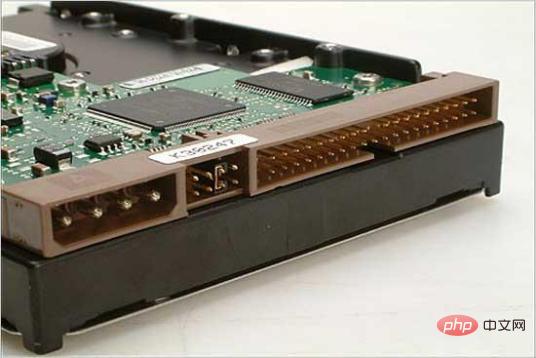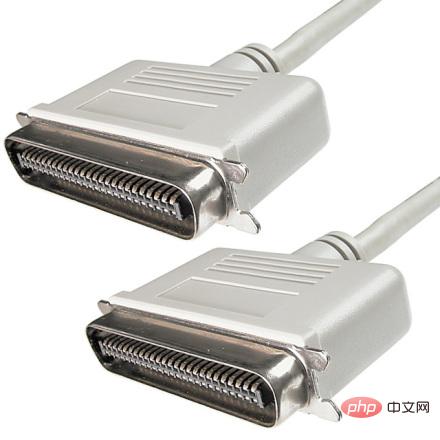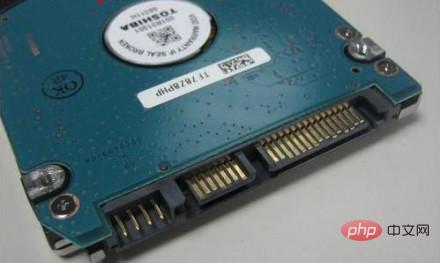
The hard disk interface is used to connect the hard disk or "host system". The hard disk interface is the connection component between the hard disk and the host system. Its function is to transmit data between the hard disk cache and the host memory. Different hard disk interfaces determine the connection speed between the hard disk and the computer. The quality of the hard disk interface directly affects the speed of program running and the performance of the system.

The operating environment of this tutorial: Windows 7 system, Dell G3 computer.
The hard disk interface is used to connect the hard disk or "host system".
The hard disk interface is the connection component between the hard disk and the host system. Its function is to transmit data between the hard disk cache and the host memory.

Different hard disk interfaces determine the connection speed between the hard disk and the computer. In the entire system, the quality of the hard disk interface directly affects the speed and speed of program running. System performance is good or bad.
From an overall perspective, hard disk interfaces are divided into five types: IDE, SATA, SCSI, SAS and Fiber Channel. IDE interface hard disks are mostly used in home products and are also partially used in servers. SCSI interface hard disks are mainly used in It is used in the server market, while Fiber Channel is only used on high-end servers and is expensive. SATA is mainly used in the home market, including SATA, SATA II, and SATA III, which are now mainstream.
IDE
IDE's full English name is "Integrated Drive Electronics", which means "electronic integrated drive". Its original meaning is Refers to the hard drive that integrates the "hard disk controller" and the "disk body". Integrating the disk body and the controller reduces the number and length of cables for the hard disk interface, enhances the reliability of data transmission, and makes hard disk manufacturing easier, because hard disk manufacturers no longer need to worry about whether their hard disks are Compatible with controllers from other manufacturers. For users, the hard drive is also more convenient to install. The interface technology of IDE has been continuously developing since its birth, and its performance has been continuously improved. Its low price and strong compatibility have made it irreplaceable by other types of hard drives.
IDE represents a type of hard disk, but in actual applications, people are also accustomed to using IDE to refer to the earliest IDE type hard disk ATA-1. This type of interface has been developed with the development of interface technology. was eliminated, and later developed and branched out to more types of hard disk interfaces, such as ATA, Ultra ATA, DMA, Ultra DMA and other interfaces, which are all IDE hard disks.
There are three transmission modes for IDE hard disks: PIO (Programmed I/O) mode, DMA (Direct Memory Access) mode, and Ultra DMA (UDMA) mode.
SCSI

The full English name of SCSI is "Small Computer System Interface" (Small Computer System Interface), which is the same as IDE ( ATA) are completely different interfaces. The IDE interface is a standard interface for ordinary PCs, while SCSI is not an interface specifically designed for hard drives. It is a high-speed data transmission technology widely used on minicomputers. The SCSI interface has the advantages of wide application range, multi-tasking, large bandwidth, low CPU usage, and hot-swappability. However, the higher price makes it difficult to be as popular as IDE hard drives. Therefore, SCSI hard drives are mainly used in mid- and high-end servers. and high-end workstations.
Fiber Channel
The English spelling of Fiber Channel is Fiber Channel. Like the SCSI interface, Fiber Channel was not originally an interface technology designed and developed for hard disks. It was specifically designed for networks. System design, but with the demand for speed in storage systems, it was gradually applied to hard disk systems. Fiber Channel hard disks were developed to improve the speed and flexibility of multi-hard disk storage systems. Its emergence has greatly improved the communication speed of multi-hard disk systems. The main features of Fiber Channel are: hot-pluggability, high-speed bandwidth, remote connections, large number of connected devices, etc.
Fiber Channel is designed for multi-hard disk system environments such as servers. It can meet the needs of high-end workstations, servers, mass storage subnetworks, and peripherals for bidirectional and serial data through hubs, switches, and point-to-point connections. Communication and other systems have requirements for high data transmission rates.
SATA

Hard drives using the SATA (Serial ATA) port are also called serial hard drives. They are the mainstream trend of PC hard drives in the future and now. In 2001, the Serial ATA Committee composed of major manufacturers such as Intel, APT, Dell, IBM, Seagate, and Maxtor officially established the Serial ATA 1.0 specification. In 2002, although Serial ATA related equipment has not yet been officially launched, Serial ATA The ATA committee has taken the lead in establishing the Serial ATA 2.0 specification. Serial ATA uses a serial connection method. The Serial ATA bus uses an embedded clock signal and has stronger error correction capabilities. Compared with the past, its biggest difference is that it can check the transmission instructions (not just data). If Errors are automatically corrected when found, which greatly improves the reliability of data transmission.
SATAⅡ interface
SATA Ⅱ is developed on the basis of SATA. Its main feature is that the external transmission rate is 1.5Gbps from SATA. (150MB/sec) has been further increased to 3Gbps (300MB/sec). In addition, it also includes NCQ (Native Command Queuing, native command queue), port multiplier (Port Multiplier), staggered spin-up and a series of other Technical characteristics. A mere external transfer rate of 3Gbps is not true SATA II.
The key technology of SATA II is the 3Gbps external transmission rate and NCQ technology. NCQ technology can optimize the instruction execution sequence of the hard disk to avoid mechanically moving the magnetic head to read and write different positions of the hard disk in the order of receiving instructions like traditional hard disks. On the contrary, it will sort the instructions after receiving them. The subsequent magnetic heads will be addressed in a highly efficient sequence, thus avoiding the loss caused by repeated movement of the magnetic heads and extending the life of the hard disk. In addition, not all SATA hard drives can use NCQ technology. In addition to the hard drive itself supporting NCQ, the SATA controller of the motherboard chipset is also required to support NCQ. In addition, NCQ technology does not support FAT file system, only NTFS file system.
SAS
SAS (Serial Attached SCSI) is a new generation of SCSI technology, which is the same as the popular Serial ATA (SATA) hard drive. They all use serial technology to obtain higher transmission speeds, and improve internal space by shortening the connection lines. SAS is a new interface developed after the parallel SCSI interface. This interface is designed to improve the performance, availability and scalability of storage systems, and provides compatibility with SATA hard drives.
SAS interface technology is backward compatible with SATA. Specifically, the compatibility between the two is mainly reflected in the compatibility of the physical layer and the protocol layer. At the physical layer, the SAS interface and the SATA interface are fully compatible. SATA hard disks can be used directly in the SAS environment. In terms of interface standards, SATA is a sub-standard of SAS, so the SAS controller can directly control SATA hard disks, but SAS However, it cannot be used directly in a SATA environment because the SATA controller cannot control the SAS hard disk; at the protocol layer, SAS consists of 3 types of protocols, and the corresponding protocols are used for data transmission according to different connected devices. The Serial SCSI Protocol (SSP) is used to transmit SCSI commands; the SCSI Management Protocol (SMP) is used to maintain and manage connected devices; and the SATA Channel Protocol (STP) is used to transmit data between SAS and SATA. Therefore, with the cooperation of these three protocols, SAS can be seamlessly integrated with SATA and some SCSI devices.
The backplane of the SAS system can connect either dual-port, high-performance SAS drives or high-capacity, low-cost SATA drives. So SAS drives and SATA drives can exist in the same storage system at the same time. However, it should be noted that SATA systems are not SAS compatible, so SAS drives cannot be connected to the SATA backplane. Due to the compatibility of the SAS system, users can use hard drives with different interfaces to meet the capacity or performance needs of various applications. Therefore, they have more flexibility when expanding the storage system, allowing storage devices to maximize investment benefits.
In the system, each SAS port can connect up to 16256 external devices, and SAS adopts a direct point-to-point serial transmission method, with a transmission rate of up to 3Gbps, and it is estimated that there will be 6Gbps or even 12Gbps in the future. The high-speed interface appears. The interface of SAS has also been greatly improved. It provides both 3.5-inch and 2.5-inch interfaces, so it can suit the needs of different server environments. SAS relies on SAS expanders to connect more devices. Most expanders have 12 ports. However, according to the product development plan of board card manufacturers, 28- and 36-port expanders will be introduced in the future to connect SAS devices, host devices or other devices. SAS expander.
Compared with traditional parallel SCSI interfaces, SAS has not only significantly improved the interface speed (the mainstream Ultra 320 SCSI speed is 320MB/sec, while SAS has just started reaching 300MB/sec, and will reach 600MB/sec in the future) sec or even more), and due to the use of serial cables, not only longer connection distances can be achieved, but also anti-interference capabilities can be improved, and this thin cable can also significantly improve the heat dissipation inside the chassis.
For more related knowledge, please visit the FAQ column!
The above is the detailed content of The hard drive interface is used to connect hard drives or something. For more information, please follow other related articles on the PHP Chinese website!
 What to do if the installation system cannot find the hard disk
What to do if the installation system cannot find the hard disk
 Recommended hard drive detection tools
Recommended hard drive detection tools
 Introduction to hard disk performance indicators
Introduction to hard disk performance indicators
 What are the video server configuration parameters?
What are the video server configuration parameters?
 Introduction to hard disk interface types
Introduction to hard disk interface types
 Introduction to hard disk interface types
Introduction to hard disk interface types
 iPhone 16 expected launch time
iPhone 16 expected launch time
 The difference between console cable and network cable
The difference between console cable and network cable